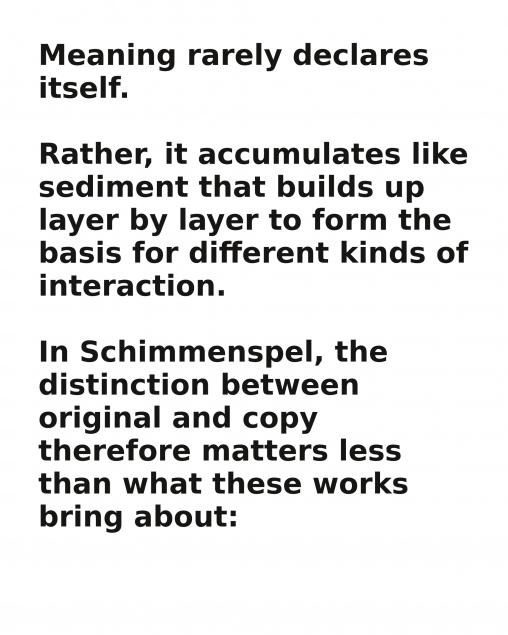In Proximity Of – On Schimmenspel, a video installation by Iratxe Jaio and Klaas van Gorkum
Niels Bekkema wrote a text about our video-installation Schimmenspel. Full text can be found at: Witte Rook Publications. Read an excerpt below.
The significance of an institution can be measured by the size of its archive,
a truth that certainly applies to the copyist program of the Prado Museum in Madrid. Ana Maria Martín Bravo wheels a cart into the climate-controlled documentation room, adjacent to the museum library. The cart holds five large registration books and a white cushion. A few months earlier, Iratxe Jaio had visited this very archive as part of the research residency she undertook with her partner, Klaas van Gorkum, at the invitation of Witte Rook.
Witte Rook is a platform for research, experiment, and reflection in the visual arts, based in Breda. In the autumn of 2023, they asked Jaio and Van Gorkum for a contemporary perspective, as artists, on the shared Spanish and Dutch history. Renowned for their long-term, research-based projects at the intersection of anthropology, sociology, archaeology and visual art, the duo chose to focus on The Surrender of Breda by Diego Velázquez, and in particular, the many copies of this painting located in various semi-public locations in Breda.
Ana Maria places the cushion on the immaculate table, presses a hollow into its surface with her hand, and opens one of the books within it. I look down at the yellowed pages: rows of artists' names, titles of paintings, and the dimensions of the canvases they carried. Several months earlier, Iratxe had combed through these books to track down the signatures of the copyists responsible for replicas now spread throughout Breda and Helmond: in the Castle of Breda, the Castle of Helmond, Stedelijk Museum Breda, and the City Hall.
The artists approached the replicas they found at these locations less as artworks and more as artefacts – real fakes, in their words – objects that not only frame social interactions but also subtly structure them. At each site, they filmed how people moved, waited, posed, or otherwise performed in the presence of the paintings.
The resulting footage formed the basis of Schimmenspel, a three-channel video installation. The ongoing soundtrack suggests continuity between locations, causing the distinction between the different spaces to dissolve. Instead, what emerges is a strange, hybrid space where real and unreal, ignoring and posing, theatricality and documentary intertwine – with the painting serving as a motif that interconnects all scenes.
The choice to focus on The Surrender of Breda is anything but arbitrary. The painting depicts Justinus of Nassau handing over the keys to the city to Ambrogio Spinola, marking the end of the Siege of Breda. Yet the handover takes place on a hill that does not exist in Breda. Velázquez never visited the city. He based his composition on a play by Calderón de la Barca. The Surrender is therefore not an accurate rendering of a historical event, but a representation of a representation.
This layering of representation,
where each new stratum moves further away from the original event and in doing so raises fundamental questions about how meaning is constructed, is central to the work of Jaio and Van Gorkum. Meaning rarely declares itself. Rather, it accumulates like sediment that builds up layer by layer to form the basis for different kinds of interaction. In Schimmenspel, the distinction between original and copy therefore matters less than what these works bring about: how they derive value from the social and spatial contexts in which they operate, and the forms of engagement they make possible.
One such form of engagement is physical proximity to the subject. “It’s a way of connecting with these people,” Iratxe told me during one of our phone calls, “and of giving the research a bodily dimension. We found a great deal of information online, but the experience of seeing those books – especially the signatures of the copyists – is something entirely different. It becomes a kind of contact object: something tangible that, through the archive, links you to other artists who’ve also worked with this painting.”
One everyday yet telling scene in Schimmenspel makes this idea of the painting as a tactile contact object concrete: museum technicians remove the canvas from the wall. One of them steadies it with her hand at its centre. Once it is laid on the floor, the stretcher bars, staples, and mounting plate that keep the canvas taut are revealed. Later, they rehang it for an exhibition on the House of Nassau at the Stedelijk Museum Breda. For a brief moment, the painting ceases to be a depiction of a military surrender and becomes, instead, an unwieldy object transferred from one symbolic space to another.





